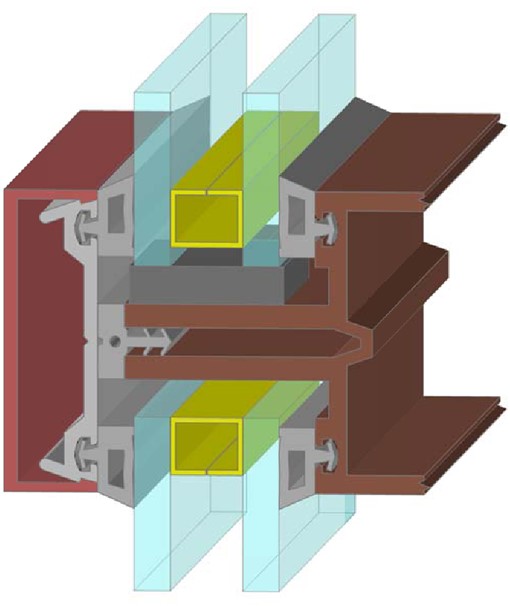The performance of the exterior façade not only depends upon the type of framing system, but the ability of the secondary system components to support that performance. One of the most important secondary components is the glazing system gaskets and blocks. These products play a vital role in isolating the glazing materials from the frame, while absorbing movement and shedding the initial moisture.
If aluminum systems for a project are purchased by an installer from a manufacture, then it is obviously the manufactures responsibility to provide these products as part of the system. It is still incumbent upon the installers to know the particular properties, purposes and placement of these materials.
If aluminum systems are internally designed and components are procured by an installer, then it is critical to develop a partnership with a manufacture to collaborate on these components. It is the responsibility of manufacture / installer to understand how these components work and when utilized properly, allow the systems to meet the specified criteria.
Guided by GANA and ASTM standards, common glazing gaskets are typically extruded in EPDM or silicone for a continuous mechanical engagement into the framing members. The hardness of the gaskets, solid or hollow, varies based upon their purpose. The density/hardness of the gasket is measured in durometers; higher the number, denser the product. Gaskets are based on a Shore A scale as it is a softer product for hardness (Shore scale range from A – D) in conformance to ASTM standards. Typically, soft compression gaskets are used in combination with dense compression gaskets on opposite side of glazing or pressure applied by means of pressure-glazing stops on opposite side of glazing.
All products are subject to testing for hardness, compressive ability, ozone resistances, tensile strength, elongation, heat aging, tear strength, brittleness temperature, non-staining and flame propagation test.
The material make-ups of these material are categorized in two main ways, Thermoset Polymer and Thermoplastic Polymers. Thermoset Polymers are heat cured. Once cured, they remain in a solid state where the physical and chemical transformation is not reversible. Common thermoset polymers are EPDM, Neoprene and Silicone.
- EPDM Rubber (or ethylene propylene diene monomer) is synthetic rubber with high density. It is an ideal outdoor material and exhibits properties found in both natural rubber and synthetic rubber. EPDM materials are less costly with higher tensile strength and abrasion resistance than silicone materials. The EPDM is heat cured in two ways, sulfur or peroxide. In some instances, sulfur cured gaskets can discolor silicone sealants; therefore, peroxide-cure may be preferred. The only available color for EPDM is black.
- Neoprene Rubber (or Polychloroprene) is a versatile synthetic rubber with exceptional resistance to oil, petroleum, and weathering, but it is typically not preferred as it is an older technology. Neoprene polymers must be enhanced to offer good UV, ozone and chemical stability, with flexibility over a wide temperature range, and superior abrasion resistance. Neoprene is often found in various other industries and applications.
- Silicone Rubber is made from an element called Silicon. It is an inorganic material unlike many of the other polymers which are petroleum based. Because of its chemistry, it very resistant to the UV and will not degrade. It bonds very well to silicone sealants and is chemically compatible, but it is softer and has lower tear strength than the EPDM. It is available in other colors like the silicone sealants, but the cost will be higher and lead times longer for color matches.
Thermoplastic Polymers are plastic polymers which must be cooled to cure. They can melt in relatively low temperatures and the physical transformation can be reversible. Common thermoplastic polymers are known as Vinyl, PVC, ASA, and TPO. There are also hybrids, TPE-TPV, Santoprene, Sarlink, Alcryn, etc.


For the glazing industry, these products are vital in the systems performance. Guided by GANA standards, the typical product and uses include the following.
- Glazing gaskets provide a critical compression seal to the interior and exterior of the glazing surface, evaluated by the inability of a thin object to pass between the glass and gasket. Failure to verify compression could allow a greater volume of water in the glass pocket, potentially compromising performance.
Installation standards typically require that gasket should be compressed in the frame raceway and not stretched, as to not result in post-installed open gaps. Since the most vulnerable part for water or air intrusion is at the corners, sealing corners is recommended. For superior performance, many firms will elect to provide molded corners.
- Structural silicone or silicone compatible spacer gaskets provide a minimum space between the aluminum system and glass for the structural silicone bond.
- Thermal isolators are commonly used in pressure cap applications, between the body of the frame and an exterior cap. Snap on isolator clips are also commonly used as simple spacers on thermally improved systems.
- Wiper seals or finger gaskets are typically pull-in engaged to the extrusion raceway and act as an initial water shed or moisture barrier.
- Bulb gaskets act in compressive detail typically at moving parts such as male-female mullion configurations or operable window sections.
- Setting blocks, per GANA standards, should be adequate to support the full depth of glazing, two per lite, at no less than 4” in length and typically located at the quarter points, but no less than the eighth points of the base of the glass. Block height must be adequate to maintain minimum glass edge clearance and must not restrict water drainage. Neoprene, EPDM or silicone setting blocks should be compatible with the insulating glass seals. Silicone setting blocks would be highly preferred as most insulated units have silicone sealant as the secondary seal.
- Anti-walk blocks or “W” blocks are typically used in non-structural silicone conventionally glazed applications. The placement of the anti-walk blocks allows the glass to stay centered in the opening of a framing system that is moving laterally due to thermal and/or seismic racking.
Understanding the fundamentals and purpose of these materials allow for the proper applications and their ability to support the system performance.
